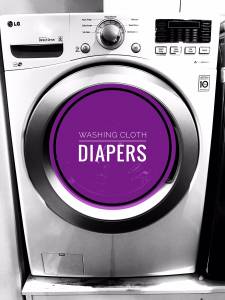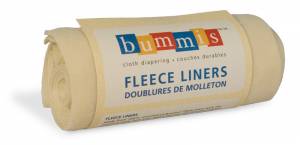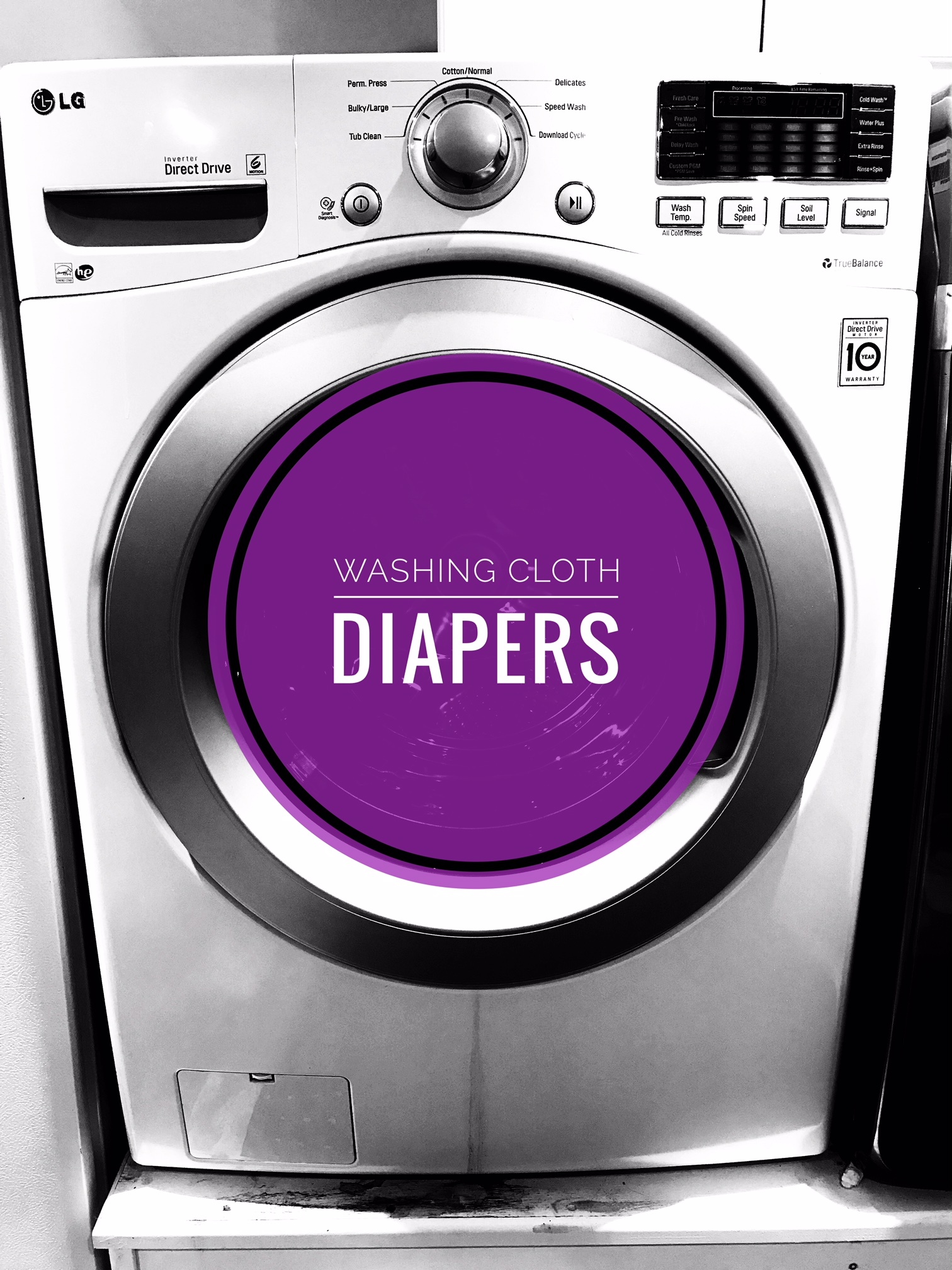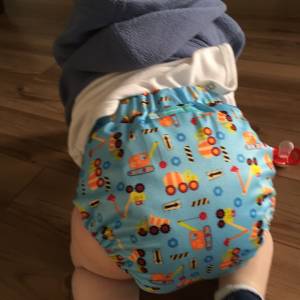I have been cloth diapering for a few years now, and running The Diaper Shop for about a year and a half. But there is one topic that still makes me slightly hesitant; washing cloth diapers. Why? I’m not sure. But I knew it was time to address the topic on the blog so I decided to turn to a fellow cloth diapering mama. I’ve gotten to know Kelly through the cloth diaper community here in Windsor/ Essex County. So read on to learn more about her, and washing your cloth diapers!
Kelly Webster is a cloth diapering advocate, teacher, and mom of two girls in Windsor, ON. She has been cloth diapering since her first daughter was approximately 3 months old and primarily uses pocket diapers. Kelly passionately promotes cloth diapering in her community and local cloth group Windsor and Essex Cloth Diapering Group.

Wash Routine
Amongst cloth diapering families, finding a good wash routine seems to be one of those elusive yet recurring topics. What type of detergent? How many rinses? How many cycles? Can you use fabric softener? Should you add any water softeners? How hard is your water? Front loader or top loader? The questions are seemingly endless! For someone wanting to start cloth diapering, it can be daunting and overwhelming. I’m going to do my best to share some general rules of thumb and the reasons behind them when it comes to establishing a solid wash routine with your cloth diapers.
I am not a chemist, scientist, or “expert” of any kind; however, I am a mother of two who has been successfully cloth diapering for approximately 4.5 years. I have learned by trial and error, researched, and gratefully absorbed bits of information from many parents who started cloth diapering long before me. My hope is to address some myths about proper washing and help you get started establishing a simple and solid washing routine. I will not be going into specialized or specific wash routine issues but will provide general rules of thumb to follow. If Emily invites me back for another post I would be happy to address other more unusual issues!
The Basics
Okay, before we move forward, there are a few simple things we need to establish: cloth diapers are the hardest working, dirtiest, piece of laundry you will clean. And by dirty I don’t mean gross. I mean just that – they’re dirty. Cleaning them properly is essential. If you don’t you can have issues with stink, rashes, and leaks. Keep in mind, the vast majority of people are able to establish a good wash routine with little issue. Don’t let troubleshooting groups like Fluff Love scare you into thinking everyone has wash routine issues. Before you do anything, get a water test kit from a pet store and check your water’s hardness. Just because your neighbour has slightly hard water doesn’t mean yours will be the same. The mineral content of tap water can vary from house to house, street to street, and neighbourhood to neighbourhood. Before you start diapering just test it. It’s easier to prevent issues with your diapers than to try to fix them later.
Do I really have to wash them twice?
For your dirtiest load of laundry, you need to use two wash cycles every time you wash. The first cycle removes most of the soil on your diapers, such as exclusively breast fed poops and urine, and rinses it away. The second cycle does the bulk of the cleaning. It cleans deep down into the fibres of your diapers or inserts and removes any soil so it’s ready to absorb the next thing your baby throws at it. One long cycle is not recommended because the diapers are essentially swishing around in the dirty water before the final rinse. The rule of thumb is always two cycles. Many people use a shorter cycle for their first wash and a longer, more heavy duty cycle for their second wash. The exact cycle to choose depends on your washer. You can find washing machine specific information on Fluff Love. Most people with an older model front loader with an agitator will need to choose the longest cycle their machine offers for one or both cycles such as a “heavy duty” cycle. Front loaders such as my machine often offer a “quick wash” cycle which can be used for the first wash and a “normal” cycle which can be used on the heaviest soil level for their second wash. Generally, HE machines use less water than older models. Older models use more water but have shorter wash cycles. Hence why those using older machines sometimes need to use the longest cycle for both washes whereas someone using a newer HE machine can use a shorter cycle and then a longer cycle. Additionally, since HE machines use less water some people need to use a “water plus” option and add additional water to the cycle.
Many people prefer an older, non-HE machine with an agitator for their diapers; however, you can clean your diapers successfully on virtually any machine. Sometimes finding the right combination of cycles and settings takes a bit of experimenting but it is worthwhile and very possible. Most people use a small amount of detergent in the first load and more in the second load. There is a happy place between not enough detergent (dirty diapers) and too much (too many suds in your machine or detergent build up on your diapers).
Generally, it’s best to wash every 2-3 days until you have a well- established routine. After that, you might be able to stretch to longer stretches between washes like 4 or possibly 5 days.
But why can’t I use an all natural detergent?
One of the reasons I chose cloth diapers for my children is because I didn’t want their sweet bums exposed to the chemicals in disposable diapers. I thought that my all natural “detergent” which I had been using on my clothes would do just fine in cleaning them properly. I was wrong. After about 6 months we had ammonia (hello barnyard stink!) and I realized I needed to do more research. I found out that natural “detergents” are actually just laundry “soaps” and generally will not clean your diapers properly. They can allow minerals from your water to build up on your diapers along with soil from your child’s urine and stool. When all this gunk builds up on your child’s diapers it can cause rashes, stink, and decrease the absorbency of your diapers which can result in leaks or even repelling. Generally, traditional detergents such as Tide Original Powder are considered the most effective to clean cloth diapers. Tide has a softener built into its detergent which means that if you have slightly hard water you won’t need to add an additional water softener. Some people have extremely hard water and need to add an additional water softener such as Calgon. Testing your water prior to beginning will let you know if you need to do this. There are other acceptable detergents other than Tide Original Powder. Some people prefer liquid detergents and anecdotally report that their diapers are cleaner with liquid Tide, for instance. A full list of recommended detergents are available on Fluff Love. When purchasing your detergent, make sure you purchase an HE detergent if you have an HE machine otherwise you will have a suds explosion in your laundry room. Additionally, don’t purchase detergents with added bleach or any type of fabric softeners. Fabric softeners are designed to coat the fibres of fabric. Anything coating the fibres of your diapers or inserts will impact their ability to absorb urine properly. Do not add scent boosters, fabric softeners, or dryer sheets to your diaper laundry. If you are having an issue with odours, you likely need to change at least one aspect of your wash routine. I have heard people tout their success with all natural “detergents” such as Rockin’ Green or Laundry Tarts. I always take these “success” stories with a grain of salt. My bet is that if we did a strip (if you don’t know what this is stay tuned for my next post) of their diapers we would find a whole lot of build up and gunk come out of them.
But what about the poop?
When people find out we cloth diaper, inevitably we hear the question, “but… what do you do with… the poop?” If your child is exclusively breastfed (EBF), which means they do not consume formula or solids and only consume breast milk, their BMs are water-soluble. You can put it directly into your diaper pail and directly into your washing machine without removing it. It will easily come off during the first wash cycle and be flushed out of your machine with the rinse cycle. As soon as you introduce solid foods or formula into your child’s diet you need to remove the BMs prior to placing the diapers into the washing machine. This because those BMS are not water-soluble. They will not easily wash away in the machine and might linger inside your machine instead. Often, people ask how they will know when they need to start doing this after introducing solid foods. Trust me… you’ll know. The texture and general appearance of the BM changes completely. Depending how many solids or how much formula your child gets (especially if you are supplementing with formula) you might notice that some BMs are fine to go in the machine whereas others should not. Trust me, once it’s time to cross that bridge you’ll just know.
There are many ways to effectively remove BMs from diapers including scraping, dunking and swishing, using disposable or microfleece liners, or using a sprayer. Research your options. What works for one family might not work for you and that’s totally okay! Whatever you choose, there is no requirement to be up to your elbows in poop. I don’t believe I have any additional hands on contact with BMs compared to any disposable using family except that we don’t get the poopsplosions that often accompany disposable diapers.


Can I use any type of diaper cream?
No, some creams are considered cloth “safe” and some are not. Generally, avoid Penaten or creams with zinc in the ingredients. These creams do not easily wash away and coat the fibres of your diapers and should be avoided at all costs. Should you need to use a heavy duty cream like this, you might be able to effectively prevent the cream from coming into contact with your diaper by using a microfleece liner.
Drying Time
As a rule of thumb, any diaper components with elastics or PUL (water- resistant layer) should not be put into the dryer. Dryer usage can significantly reduce the lifetime of those diapering items. Inserts and cloth wipes can go in the dryer freely. Should you need to put a diaper shell or all-in-one diaper in the dryer, you should use a low heat setting and put it in the minimum amount of time required. Additionally, ensure any pocket diapers have cooled entirely before stuffing inserts in them to avoid ripping the PUL. Investing in a clothesline or drying rack is strongly recommended for cloth diapering.
Not Your Mama’s Cloth Diapers
Modern cloth diapers tend to be different than the flats and plastic pants which were used in the 80s and 90s. Those options still work quite effectively however modern cloth diapers have evolved beyond them. There are so many options available now virtually everyone can find a style and system which works for their family. For this reason, much of the advice you’ll hear from previous generations might no longer be applicable. Here are a few tips which you might want to avoid:
-soak your dirty diapers in a wet pail (ie. a bucket of water) between washes [please don’t do this… use an open diaper pail or wet bag to reduce stink and the moisture rich bacteria breeding ground of a wet pail]
-soak them in vinegar between washes [trust me, just don’t do this… it will significantly reduce the life of your elastics and isn’t helpful or required in any way]
-just add some bleach to each wash cycle [this is absolutely not necessary if you have an effective wash routine and can impact the overall life of your diapers]



Share This Article
Choose Your Platform: Facebook Twitter Google Plus Linkedin